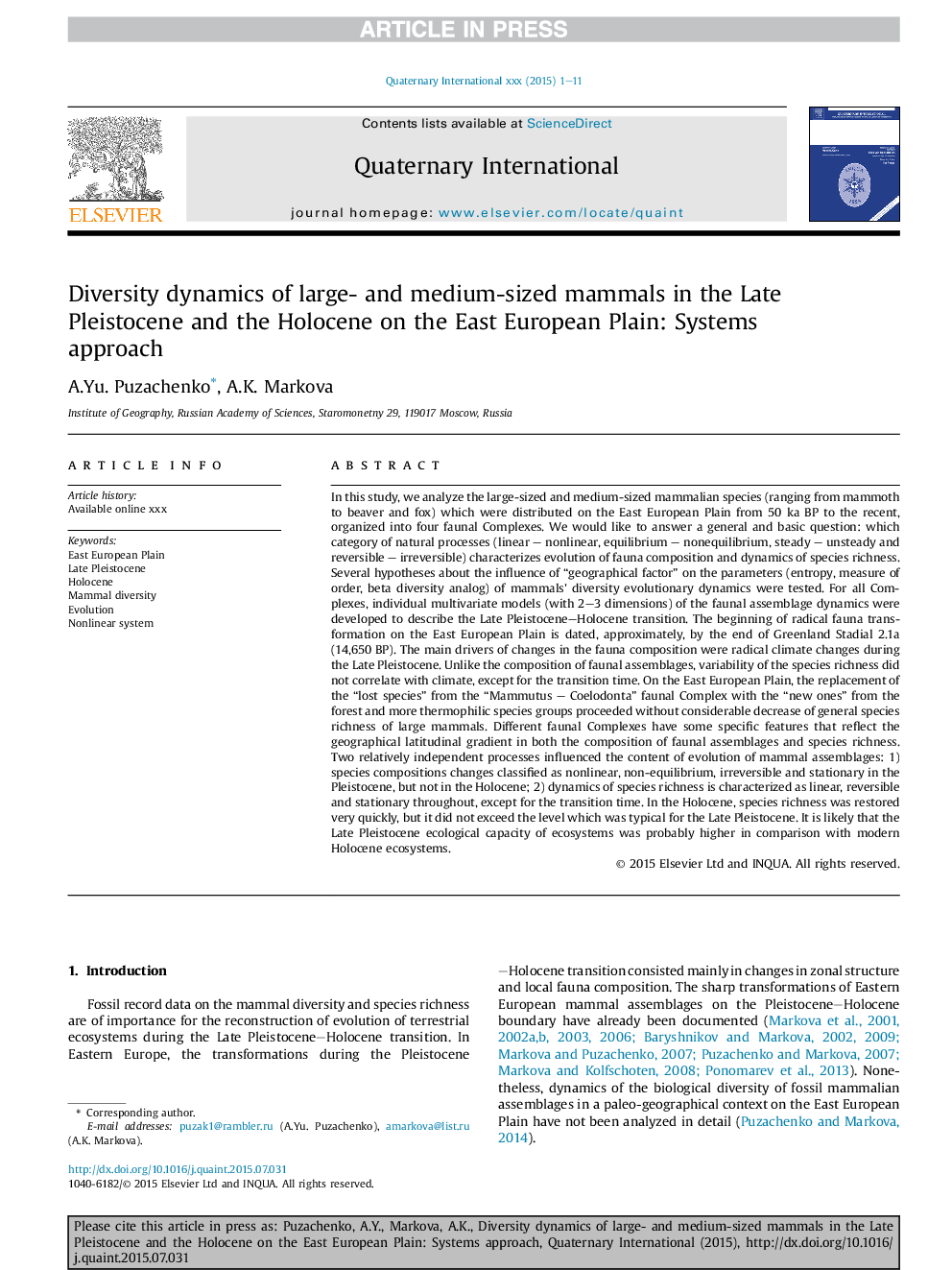| کد مقاله | کد نشریه | سال انتشار | مقاله انگلیسی | نسخه تمام متن |
|---|---|---|---|---|
| 5113979 | 1484087 | 2016 | 11 صفحه PDF | دانلود رایگان |
عنوان انگلیسی مقاله ISI
Diversity dynamics of large- and medium-sized mammals in the Late Pleistocene and the Holocene on the East European Plain: Systems approach
ترجمه فارسی عنوان
دینامیک تنوع پستانداران بزرگ و متوسط در پالیستوسن پسین و هولوسن در دشت شرق شرقی: رویکرد سیستم
دانلود مقاله + سفارش ترجمه
دانلود مقاله ISI انگلیسی
رایگان برای ایرانیان
کلمات کلیدی
دشت شرقی اروپا، پالیستوسن بعدا، هولوسن، تنوع پستانداران، سیر تکاملی، سیستم غیرخطی
موضوعات مرتبط
مهندسی و علوم پایه
علوم زمین و سیارات
زمین شناسی
چکیده انگلیسی
In this study, we analyze the large-sized and medium-sized mammalian species (ranging from mammoth to beaver and fox) which were distributed on the East European Plain from 50 ka BP to the recent, organized into four faunal Complexes. We would like to answer a general and basic question: which category of natural processes (linear - nonlinear, equilibrium - nonequilibrium, steady - unsteady and reversible - irreversible) characterizes evolution of fauna composition and dynamics of species richness. Several hypotheses about the influence of “geographical factor” on the parameters (entropy, measure of order, beta diversity analog) of mammals' diversity evolutionary dynamics were tested. For all Complexes, individual multivariate models (with 2-3 dimensions) of the faunal assemblage dynamics were developed to describe the Late Pleistocene-Holocene transition. The beginning of radical fauna transformation on the East European Plain is dated, approximately, by the end of Greenland Stadial 2.1a (14,650 BP). The main drivers of changes in the fauna composition were radical climate changes during the Late Pleistocene. Unlike the composition of faunal assemblages, variability of the species richness did not correlate with climate, except for the transition time. On the East European Plain, the replacement of the “lost species” from the “Mammutus - Coelodonta” faunal Complex with the “new ones” from the forest and more thermophilic species groups proceeded without considerable decrease of general species richness of large mammals. Different faunal Complexes have some specific features that reflect the geographical latitudinal gradient in both the composition of faunal assemblages and species richness. Two relatively independent processes influenced the content of evolution of mammal assemblages: 1) species compositions changes classified as nonlinear, non-equilibrium, irreversible and stationary in the Pleistocene, but not in the Holocene; 2) dynamics of species richness is characterized as linear, reversible and stationary throughout, except for the transition time. In the Holocene, species richness was restored very quickly, but it did not exceed the level which was typical for the Late Pleistocene. It is likely that the Late Pleistocene ecological capacity of ecosystems was probably higher in comparison with modern Holocene ecosystems.
ناشر
Database: Elsevier - ScienceDirect (ساینس دایرکت)
Journal: Quaternary International - Volume 420, 28 October 2016, Pages 391-401
Journal: Quaternary International - Volume 420, 28 October 2016, Pages 391-401
نویسندگان
A.Yu. Puzachenko, A.K. Markova,
